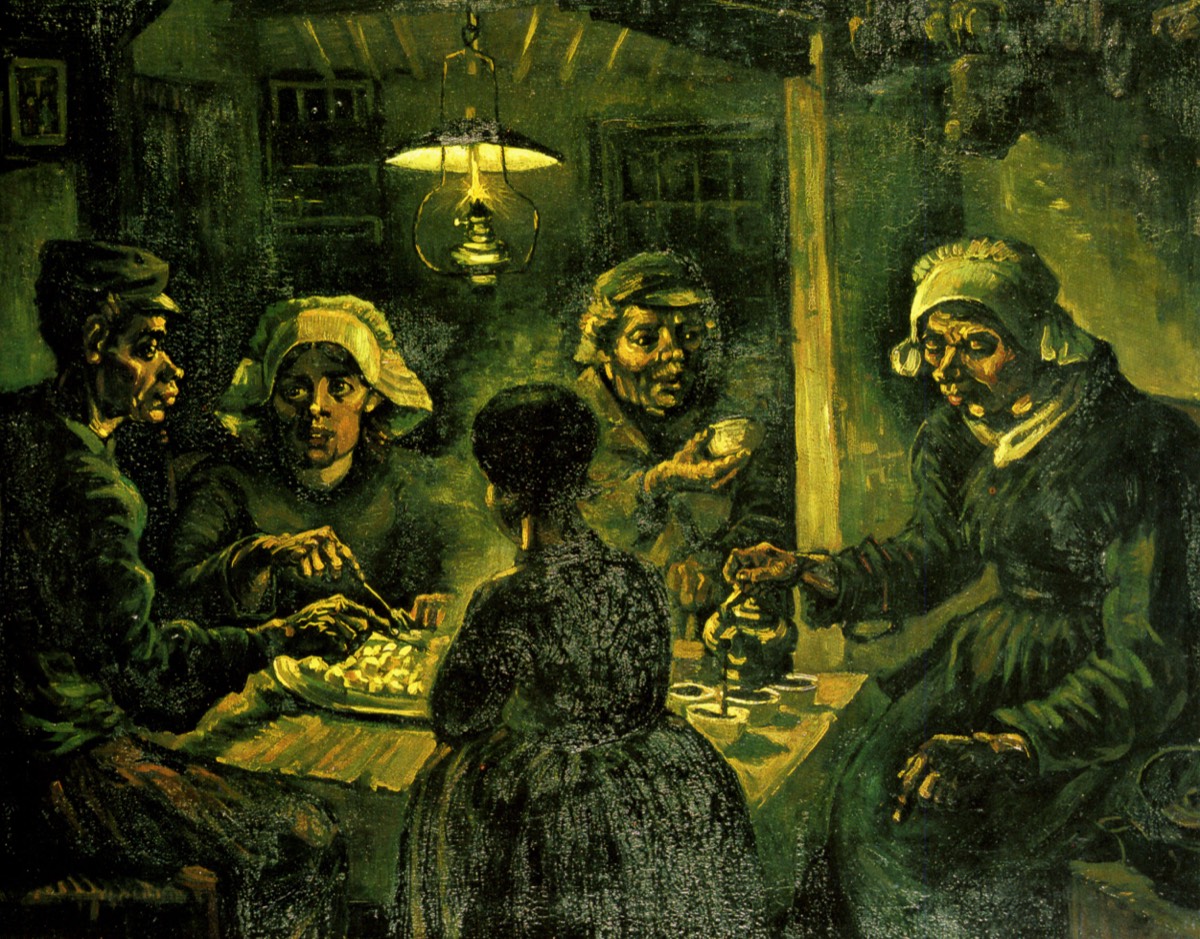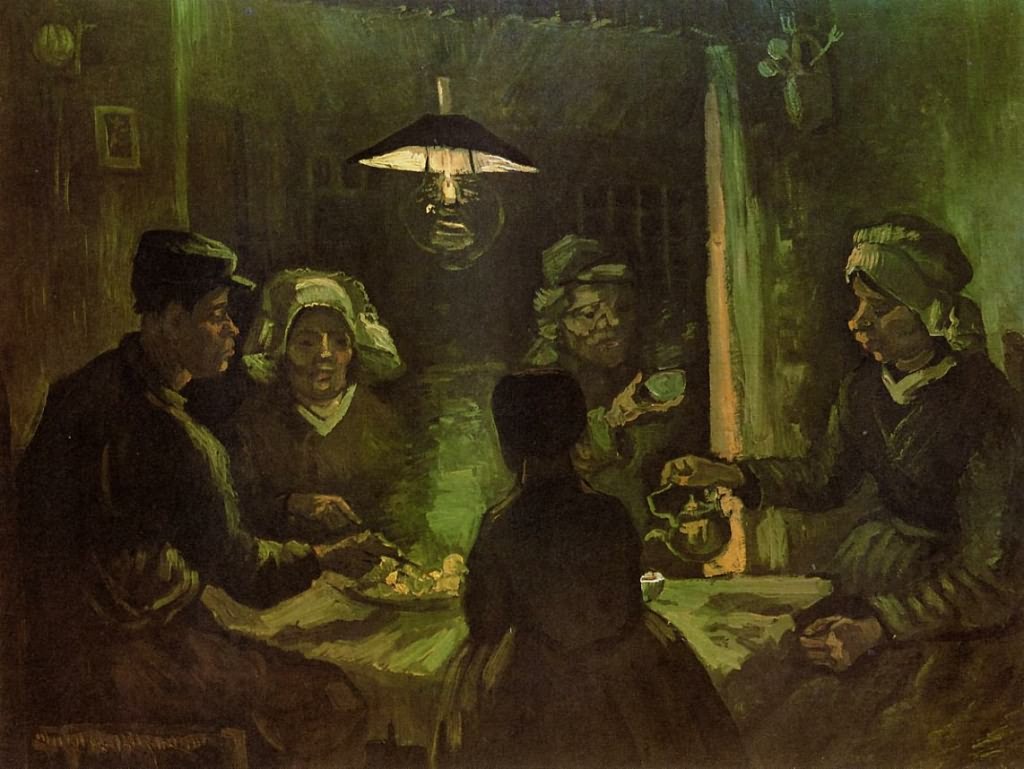The Potato Eaters
Appreciation

The Potato Eaters Nederland Vincent van Gogh Gallery and Appreciation
The Potato Eaters (Dutch: De Aardappeleters) is a painting by the Dutch painter Vincent van Gogh that he painted in April 1885 while in Nuenen, Netherlands. It is in the Van Gogh Museum in Amsterdam. The version at the Kröller-M√ºller Museum in Otterlo is a preliminary oil sketch, and he also made a version as a lithograph. In 1885 van Gogh made several versions of The Potato Eaters.
During March and the beginning of April 1885 he sketched studies for the painting, and corresponded with his brother Theo, who was not impressed with his current work or the sketches Van Gogh sent him in Paris. He worked on the painting from April 13 until the beginning of May, when it was mostly done except for minor changes which he made with a small brush later the same year.
Van Gogh said he wanted to depict peasants as they really were. He deliberately chose coarse and ugly models, thinking that they would be natural and unspoiled in his finished work: "You see, I really have wanted to make it so that people get the idea that these folk, who are eating their potatoes by the light of their little lamp, have tilled the earth themselves with these hands they are putting in the dish, and so it speaks of manual labor and ‚Ä?that they have thus honestly earned their food. I wanted it to give the idea of a wholly different way of life from ours ‚Ä?civilized people. So I certainly don‚Äôt want everyone just to admire it or approve of it without knowing why."
Writing to his sister Willemina two years later in Paris, Van Gogh still considered The Potato Eaters his most successful painting: "What I think about my own work is that the painting of the peasants eating potatoes that I did in Nuenen is after all the best thing I did". However, the work was criticized by his friend Anthon van Rappard soon after it was painted. This was a blow to van Gogh's confidence as an emerging artist, and he wrote back to his friend, "you...had no right to condemn my work in the way you did" (July 1885), and later, "I am always doing what I can't do yet in order to learn how to do it." (August 1885).
Influence of the Hague School
Van Gogh is often associated in people's minds with the Impressionist movement but in fact his artistic roots lay much closer to home in the artists of the Hague School such as Anton Mauve and Jozef Israëls.
In a letter to his brother Theo written mid-June 1884, Vincent remarks
When I hear you talk about a lot of new names, it‚Äôs not always possible for me to understand when I‚Äôve seen absolutely nothing by them. And from what you said about ‚ÄòImpressionism‚Ä? I‚Äôve grasped that it‚Äôs something different from what I thought it was, but it‚Äôs still not entirely clear to me what one should understand by it.
But for my part, I find so tremendously much in Israëls, for instance, that I‚Äôm not particularly curious about or eager for something different or newer.
Before Vincent painted The Potato Eaters Israëls has already treated the same subject in his A Peasant Family at the Table and judging from comment in a letter to Theo 11 March 1882 Vincent has seen this (or at least a variation of it) and had been inspired by it to produce his own version of it. Compositionally the two are very similar:in both paintings the composition of the painting is centered by a figure whose back is turned to us.


The Potato Eaters Nederland Vincent van Gogh Gallery and Appreciation Lithograph
For detailed commentary about "The Potato Eaters" (written by Louis van Tilborgh of the Van Gogh Museum) please refer to this page in the Visitors Submissions section.
Van Gogh made a lithograph of the composition The Potato Eaters before embarking on the painting proper. He sent impressions to his brother and later says in a letter that he made the lithograph from memory in the space of a day.
Van Gogh had first experimented with lithography in The Hague in 1882. Though he appreciated small scale graphic work and was an enthusiastic collector of English engravings he worked relatively little in graphic mediums. In a letter dated around 3 December 1882 he remarks
I believe, though, that it would be a great mistake to imagine that such things as, for instance, the print The Grace (a family of woodcutters or peasants at table) were created at a stroke in their final form. No, in most cases the solidity and pith of the small is only obtained through much more serious study than is imagined by those who think lightly of the task of illustrating ...
Anyway, some paintings in their huge frames look very substantial, and later one is surprised when they actually leave behind such an empty and dissatisfied feeling. On the other hand, one overlooks many an unpretentious woodcut or lithograph or etching now and then, but comes back to it and becomes more and more attached to it with time, and senses something great in it.